Full download ebooks at https://ebookgrade.com
For dowload this book click link below https://ebookgrade.com/product/essentials-of-autismspectrum-disorders-evaluation-and-assessment/

More products digital (pdf, epub, mobi) instant download maybe you interests ...




Designing for Autism Spectrum Disorders
https://ebookgrade.com/product/designing-for-autism-spectrumdisorders/
Cellular and Molecular Biology of Autism Spectrum Disorders
https://ebookgrade.com/product/cellular-and-molecular-biology-ofautism-spectrum-disorders/
Assessment of Autism Spectrum Disorder 2nd Edition
https://ebookgrade.com/product/assessment-of-autism-spectrumdisorder-2nd-edition/
Handbook of Assessment and Diagnosis of Autism Spectrum Disorder
https://ebookgrade.com/product/handbook-of-assessment-anddiagnosis-of-autism-spectrum-disorder/

Autism Spectrum Disorders Foundations Characteristics and Effective Strategies 2nd Edition
https://ebookgrade.com/product/autism-spectrum-disordersfoundations-characteristics-and-effective-strategies-2nd-edition/

Effectiveness of Neurofeedback Training for Children with Autism Spectrum Disorders The
https://ebookgrade.com/product/effectiveness-of-neurofeedbacktraining-for-children-with-autism-spectrum-disorders-the/

Autism Spectrum Disorders From Theory to Practice
Laura J. Hall
https://ebookgrade.com/product/autism-spectrum-disorders-fromtheory-to-practice-laura-j-hall/

Handbook of Early Intervention for Autism Spectrum Disorders Research Policy and Practice 1st Wei Zhi
https://ebookgrade.com/product/handbook-of-early-interventionfor-autism-spectrum-disorders-research-policy-and-practice-1stwei-zhi/
Another random document with no related content on Scribd:
leakage and to strengthen the joint, a long, thin batten was lashed over the outside of the joint.
The decorations of the Maori canoes are wonderful. The spiral pattern often seen in their carvings is taken from the unfolding of the frond of a fern, and has been supposed to symbolise the unfolding of life or the attainment of a planned enterprise. The greatest care and the most artistic efforts were lavished upon the carvings of the prow and stern boards. These boards were very large and always removable. The log from which the stern-board was fashioned was generally about 15 inches in diameter and 6 to 15 feet in length, and in its complete state was covered with conventional and elaborate patterns. The figurehead log was about 6 feet in length and 4 feet wide, and 2 to 4 feet in thickness. Both were of hardwood and coloured red with kokowai or ochre. If the figureheads represented the dead chiefs who had joined the immortals in the Maori heaven, they must have lost in the other world what little beauty was left to them in this world after being tattooed. Not a few of the figures are extraordinarily grotesque, and the weird effect of the red ochre is heightened by the introduction of bright shiny eyes made of the inner shell of the haliotis. Many also show the tattoo marks which were supposed to add to Maori beauty, and most bore bunches of feathers of the kaka and albatross, and on gala days were further adorned with an elaborate and gaudy feather wig. The thin batten, already alluded to, covering the join of the topside and hull, was always stained black. Gannet feathers were inserted to cover the lashings and contrasted vividly with the black batten and the reddened canoe. The sides of many canoes also were painted in wavy lines of red, white and black, as though in imitation of the wave motion. Streamers of pigeon tail feathers hung from the top of the stern-board to the water; even the sail point on the boom bore its tuft and streamers of feathers.
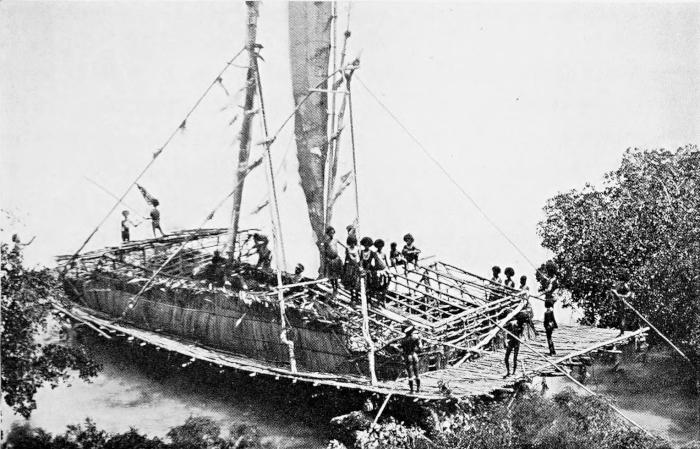
A LAKATOI NEARLY COMPLETED.
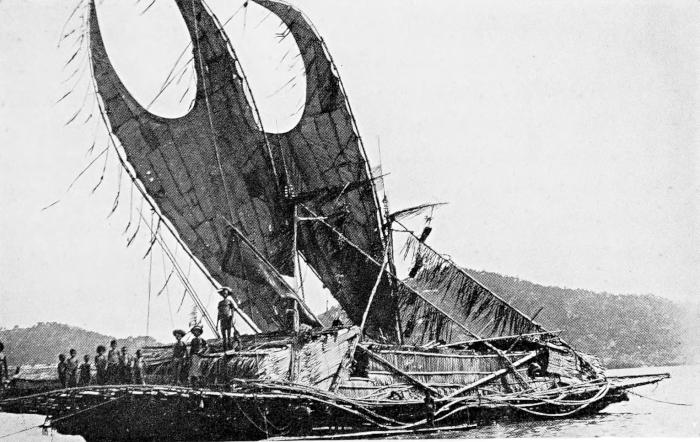
A LAKATOI UNDER SAIL.
From Photographs suppliedby the Hon. J. E. Jenkins.
The dug-out, as the type common to all the Pacific islands, usually has the outrigger attached; it can only be used in still waters. Very frequently it is duplicated to form a double canoe, or even three may be used abreast and covered, together with the intervening spaces, with a deck upon which a deck house is erected. As the deck extends a considerable distance beyond the sides the amount of deck space thus obtained is very great, as can well be imagined if the hull be formed of three canoes each 50 or 60 feet long, and the deck extends 3 or 4 feet on either side and is nearly square. If canoes with outriggers were employed as double canoes they were placed with the outriggers lashed together.
The accompanying illustrations of a New Guinea boat or “lakatoi” show how these vessels are arranged. They each carry two short pole masts which support immense spars of bamboo or other light
material to which sails of palm leaves are attached. These sails are so constructed that they can be hauled up or down their spars as required. They have been described as suggesting when under full sail gigantic lobsters holding up their claws in distress. The houses upon them are formed of rattan and palm leaves. An idea of their dimensions may be formed by comparing in the illustrations the vessels themselves and the men and women upon them.
Not the least amazing features of these boats are that long sea voyages were undertaken in them, and that in spite of their size not a nail was used in their construction, the whole thing being tied firmly together with coco-nut or other fibre.
The Fijian canoe was very similar to that just described. The Tahitian “pahi” is frequently 80 feet in length, of the raft-boat type, and bears a distinct likeness to the “balsa” of Ancient Peru, and has some of the features of the catamarans of the Chatham Islands, and “has a closer likeness still to a Chinese junk, with its high latticed stern work.”[10] These pahi were broad in the beam, neatly planked over inside, and were fitted with a bulkhead or inner casing, and had the usual elevated carved stern, sometimes consisting of one post and sometimes of two. These vessels were capable of covering 120 miles a day without much difficulty if the wind suited. The Pacific Islanders, says the same authority, “in the early days of Polynesian enterprise (about 1400 A.D. and earlier) would make voyages of over a thousand miles at a time, taking the sun as their compass by day and the moon and stars by night, adapting the time of their sailings to the shifting of the Trade wind ... veering from north-east to southwest in its appointed season.”

CANOE FROM SHORTLAND ISLAND.
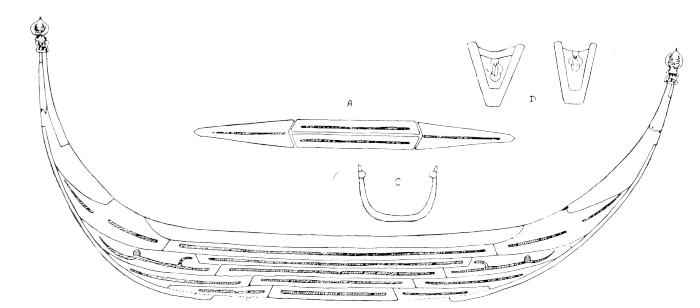
DIAGRAM OF SHORTLAND ISLAND CANOE.
a, The keel. c, The timbers. d, The small, solid, wedge-shaped timber in bow, with ornament.
Bypermission ofC. M. Woodford, Esq.. F.R.G.S., andthe RoyalAnthropological Institute of Great Britain andIreland.
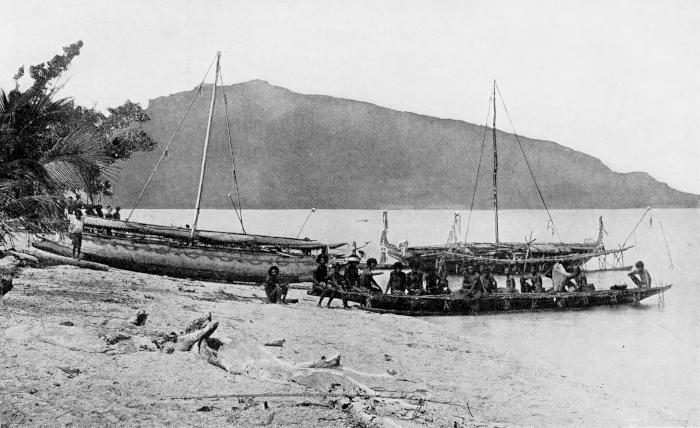
WAR CANOE, TESTE ISLAND, NEW GUINEA.
From Photographsuppliedby the Hon. J. E. Jenkins.
Unquestionably the most remarkable canoes to be found in the Pacific were those made in the Solomon Islands. Though destitute of metal tools, the islanders yet managed to design them with mathematical accuracy, to construct them to scale and in accordance with the designs, and to put them together with skill and precision. Such canoes were made by the Solomon Islanders as long ago as the sixteenth century, for de Mendaña, who visited the islands in 1568, has left a description of them. The canoes, he says, were constructed of planks, well made and light, and were crescentshaped and capable of holding about thirty persons. Later explorers have recorded that the hull was formed of a dug-out, and that topsides were added. This type of canoe appears to be peculiar to the Melanesian inhabitants of the British Solomons.[11] For neatness and accuracy the Shortland Island canoes come first, but “for beauty of line and exterior decorations the large tomako or head-hunting
canoe of the New Georgia group unquestionably excels.” The built canoes were cut with the aid only of stone implements, but now the natives use the plane iron, fitting it into the handle formerly used for the stone implement. In many canoes a central ridge is left along each plank to strengthen it, and a projecting boss is left at the places where the planks and timbers join. The timbers, or ribs, etc., are either naturally grown or shaped from the solid. The planks are properly seasoned in the building sheds, and when the canoe is being put together the various parts are accurately fitted and tied with strips of fibre through the holes in the bosses. The seams are caulked with a vegetable putty made from scraped nut kernel, which hardens in a few days. The canoes consist of garboard strakes, second, third, fourth, fifth, and gunwale strakes, stem and stern pieces, and the timbers or ribs. The last fine specimen of the headhunting canoe of the New Georgia group was 44 feet over all, 4 feet 8 inches beam, and 2 feet 4 inches deep. The height of the bow, in addition, was 9 feet 7 inches, and that of the stern 10 feet 9 inches. All the Solomon Islands canoes are ornamented with shells. A whitepainted arm on the side of the vessel has a sinister interpretation. It indicates that heads have been taken; if the arm points to the bows the victims were males; and if to the stern the collection taken up was of female heads. Both stem and stern-boards had human faces carved upon them, the idea being that the faces kept a good lookout in every direction. This was, no doubt, a pleasing fiction or a superstition; the natives placed more reliance upon their keenness of hearing and vision than upon the vigilance of the wooden faces to detect the approach of an enemy.
The Malay influence has been shown not only in the building of outrigger canoes, but in the popularity of piracy among the natives of the East Indies. Probably the Malays have been pirates ever since there has been commerce in those waters upon which to prey. It is certain that the earliest European vessels to wander into the distant Orient found the industry established, active, and prosperous. Steam navigation, improved firearms, and the electric telegraph have done much to curb the propensities of these merciless marauders, and the
influence of noble men like Rajah Brooke of Sarawak has been of equal value. But they found it a hard lesson to learn that commerce must be respected and commercial vessels let alone; it was gradually accepted as inevitable that piratical exploits would be followed by the visit of a European gunboat which would blow every Malay proa and pirate to pieces at the first opportunity. This idiosyncrasy of the Western world had to be observed, but the pirate does not take kindly to the uninterrupted ways of peace, and whenever he can he indulges in his hereditary calling, though his victims may be only small native trading boats and junks.
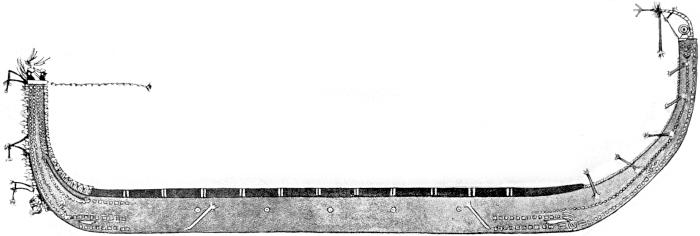
Bypermission ofC. M. Woodford, Esq., F.R.G.S., andthe RoyalAnthropological Institute ofGreat Britain andIreland.
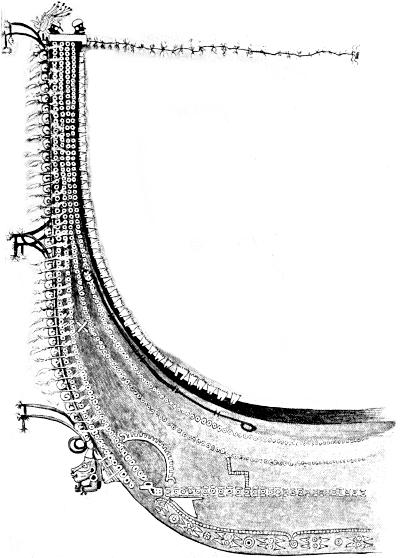
HEAD-HUNTING CANOE FROM YSABEL (DETAIL OF BOW).
Bypermission ofC. M. Woodford, Esq., F.R.G.S., andthe RoyalAnthropological Institute ofGreat Britain andIreland.
The Malay dug-outs intended for piracy or war were broader than those intended for other purposes. A writer in 1848[12] described them as built of timber in the lower part, with the upper part of rattan, bamboo, and dried palm leaves, this lighter part being added to prevent the sea washing in over the low sides. “Outside the bends,” he continues, “about a foot from the water line, runs a strong gallery in which the rowers sit cross-legged.” Apparently the
gallery was on or outside the gunwale, an arrangement which would help to steady the long, narrow hull. Then, as now, a cabin was placed in the after part for the accommodation of the chief in command of the boat, but an interesting feature of the proa he describes was an unrailed flat roof extending from the cabin roof almost the length of the ship and serving a double purpose of providing a fighting deck for the warriors and affording shelter for the crew. The weapons were the kris and spear, which “to be used with effect require elbow room.” As the Malays were energetic fighters, they were seldom long in obtaining all the elbow room necessary. A brass gun in the prow, under the flying deck, was the only firearm.
The modern Malay proa is a more ambitious affair. It is built to be light, fast under sail or oar, and very shallow in hull. The last was very necessary in vessels which usually sought safety by fleeing into waters too shallow to permit of serious pursuit. A convenient length was 64 feet, or 72 feet over all; the breadth would be 14 feet and the depth only 4 feet 6 inches. Some were longer and broader, but the Malays were usually careful to increase the draft as little as possible. The accompanying photograph is of a model of a proa having these dimensions, and recently added to the South Kensington Museum. The boat is a combination of Chinese and Malayan design. It will be noticed that the vessel has very fine lines forward, almost identical with those of the Arab dhows of the Red Sea and the Persian Gulf, a sharp run aft and shallow floors, and should be very fast. Instead of the fighting deck overhead, already described, she has a deck extending the whole length and breadth of the vessel and slightly below the level of the gunwale, an arrangement which would enable a large number of men to lie concealed behind the bulwarks and ready for instant attack. The deck has two covered hatchways. The roof of the cabin at the stern provides a platform for working the rudder and the guns, there being one brass muzzle-loader on each quarter. The projecting platforms or galleries at the bow and stern provide additional deck space and would facilitate the boarding of a prize. The boat has two
pole masts, one set very far forward and the other rather forward of amidships, neither having stays. The sails of all vessels of this class were made of strips of palm leaves, except when the pirates appropriated the sails of captured ships, as they are said to have done at times, and altered them to suit their own vessels. The Chinese type of dropping rudder, which could be raised or lowered by means of a windlass, was a common feature in these Malay proas, the use of the steering paddle being chiefly confined to the smaller craft. The vessel represented is armed with one smoothbore gun carried on the bow platform, and two similar weapons carried aft; she also had six gingals or heavy muskets mounted on swivels, and there was a plentiful supply of arms for hand-to-hand fighting.
A very similar boat to the proa, but more heavily and substantially constructed, was that specially favoured by the Dyaks in their headhunting expeditions. It was long and narrow, and could carry sixty to eighty men. The Borneo Dyaks adopted the flying deck as a fighting platform,[13] but carried the fantastically decorated stern-board to an extravagant height, which must have interfered seriously with the stability of the vessel. These stern-boards are said to have been intended as shields for the occupants of the boats, who turned them end-on to the enemy and were protected by the boards from the hostile arrows and spears.

THE FAMOUS OLD CHINESE JUNK,
Photographsuppliedby “Shipping Illustrated.”
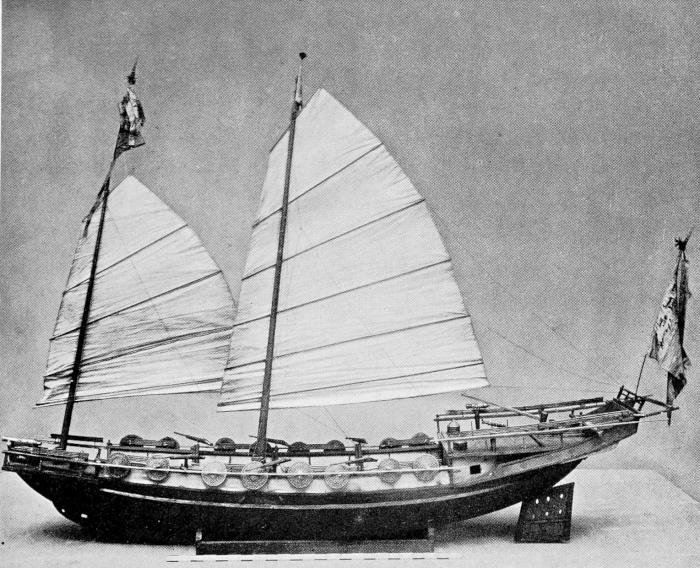
From the Modelin the Victoria andAlbert Museum. Bypermission ofR. Walters, Esq., Ware Priory, Herts.
The Chinese seem to have attained to a certain degree of civilisation many centuries ago, and then to have gone to sleep. The dwellers along her coasts were traders and, when opportunity offered, pirates, but as China maintained a policy of splendid isolation both under her old dynasties and after her Manchu conquerors assumed control of her destinies, she had little need of a navy and no interest to serve in encouraging a fighting marine. China used guns in land warfare as early as the eighth century A.D., yet in the eighteenth century she had war junks carrying, not artillery, but soldiers armed
with bows and arrows, while the sides of the vessels bore leather shields painted to look like tiger heads, to scare the enemy. Some of her junks were propelled by means of a couple of paddle wheels on each side worked by manual power. The Chinese war junks differed from the trading junks in the greater strength of their construction and in the number of guns carried. Some had guns approximating to 68-pounders, and it was not unusual to find a junk with twenty-one guns of varying dimensions. Each was the same cumbersome, slowmoving craft. These vessels were sometimes over 1,000 tons burthen. One of these junks, the Key-ing, which visited London in 1848, sailed across the Atlantic from Boston to St. Aubin’s Bay in the remarkably good time of twenty-one days, a performance comparing favourably with that of many of the western sailing ships; generally she sailed “like the wind,” that is to say, “where it listeth,” and was as likely to arrive at one port as another. Another famous junk in her time was the Whang-Ho, but whether the junk of that name which started on an exhibition tour of the world two or three years ago was the original or was a copy, as is alleged, is a point which is in dispute. She left San Francisco for New York and London, intending to make the voyage by way of Cape Horn, and soon showed that her intended port was about the last place where she might be expected. Instead of New York, she fetched up at Tahiti, where the crew went ashore and stayed. She sailed with a new crew for the stormy waters of Cape Horn, and was thought to have gone to the bottom until she turned up in Torres Straits, and nearly got into trouble through being suspected of smuggling, or carrying contraband. After being nearly wrecked off Java, she entered Batavia River, and sailed again some weeks later, but her condition became so bad that she had to be abandoned. Her captain wrote in his logbook, in October, 1909: “She will not hold together much longer.... The beams are not fastened to the hull of the vessel, but lie loose in her.... It is certain she has never been a man-of-war, but has been specially built for exhibition purposes in the most careless fashion.” A few days later she was left to her fate.
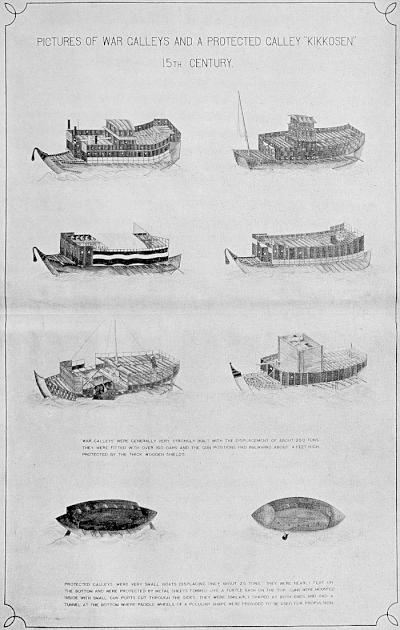
JAPANESE WAR GALLEYS AND A PROTECTED GALLEY ‘KIKKOSEN,’ 15th CENTURY.
Photographby specialpermission ofthe Japanese ImperialNavalCommissioners. (click image to enlarge)
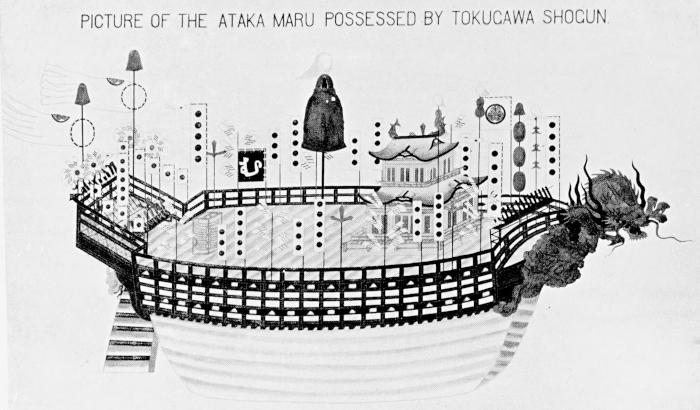
THE “ATAKA MARU.”
Photographby specialpermission ofthe Japanese ImperialNavalCommissioners.
The Japanese, who pursued a policy of isolation until they were forced to admit Western influences, were as conservative in their shipping as in everything else. Their trading junks were all built to pattern, externally and internally, decreed by the authorities, and no deviation from it was permitted. In their warships, however, a greater variety of design was allowed. As early as the fifteenth century they had sea-going ships carrying cannon, a weapon derived at some time, perhaps, in the unrevealed past, from the Chinese after the latter conferred upon the Japanese the Chinese system of writing, a religious system, and other evidences of Celestial superiority. There were several types of these war galleys, some of which are here illustrated. The vessels shown were generally very strongly built with a displacement of about 200 tons. They were propelled by over one hundred and fifty oars, and their gun positions had bulwarks about 4 feet high, protected by thick wooden shields. A smaller type of vessel, also in use at that time, may be called a
protected galley. They were very small vessels, displacing only about 25 tons each. They were nearly flat-bottomed, but had a top covering, or hood, made of metal sheets, which extended from side to side and almost from end to end, like a turtle back. Their guns were mounted inside the cover and fired through small ports cut through the sides of the vessel itself. These boats were two-ended; that is, of similar shape at either end, so that they could travel either end foremost, and they had a curious tunnel constructed along their bottoms in which a peculiarly shaped paddle-wheel was revolved by manual power for the propulsion of each vessel. The Japanese warships increased in size and ornamentation until the Ataka Maru was built. She is of more than ordinary interest, as she was the last and the largest of the old native warships built for the Japanese Government before the adoption of Western methods. She was 180 feet long by 63 feet beam and 22 feet depth, and was propelled by one hundred and thirty oars. Her armament consisted of five heavy guns and a number of smaller weapons, and her vital parts were protected by copper sheathing. The Japanese, as already stated, probably obtained their knowledge of explosives and firearms from the Chinese, and a few years ago repaid the obligation by giving the Chinese most instructive lessons in the superiority of modern methods and weapons.
One of the oldest vessels, and at the same time one possessing characteristics supposed to be essentially modern, is the Arab dhow. It is as old as the days of Alexander the Great in its chief features, and in the fineness of the lines of its hull, its seaworthiness, and its general handiness is not unlike the Viking ships, and is equal to anything of similar size that the average modern builder could produce with the same materials. They are employed in gunrunning, smuggling, and the slave trade, when, more legitimate cargoes are lacking or not sufficiently remunerative.
The Siamese were among the Eastern nations who took kindly to the sea, and were able to use their warships to some effect. Thus, about two hundred and fifty years ago, when a European power, depending upon its superior strength, took forcible possession of the
island of Junk Seylon, the King of Siam of that day ordered the “immediate building of six warships, each carrying ten guns with pattaroes, and well manned and fitted with small arms.” These vessels were built in one month, and this emergency mobilisation and the fighting orders were all to be obeyed under penalty of death and forfeiting of estates, the latter penalty being added no doubt to prevent the expectant heirs of a warrior depriving his majesty of the latter’s services.




